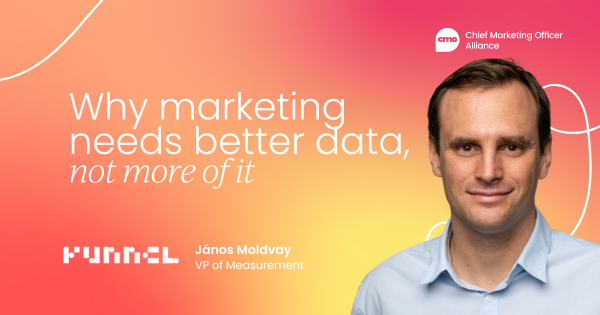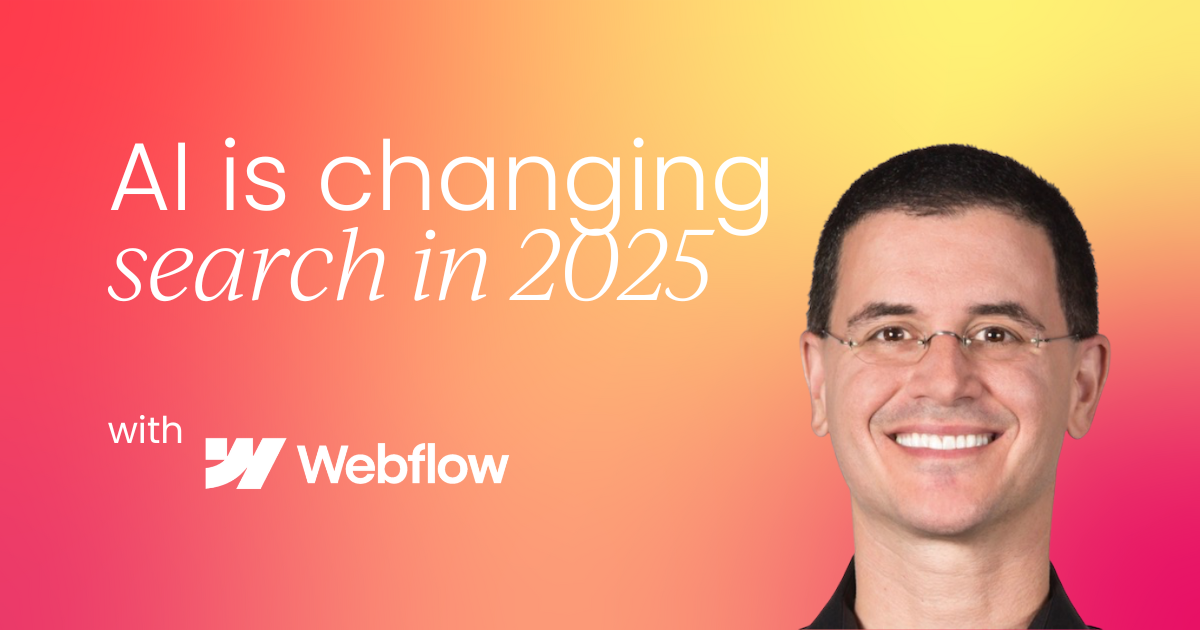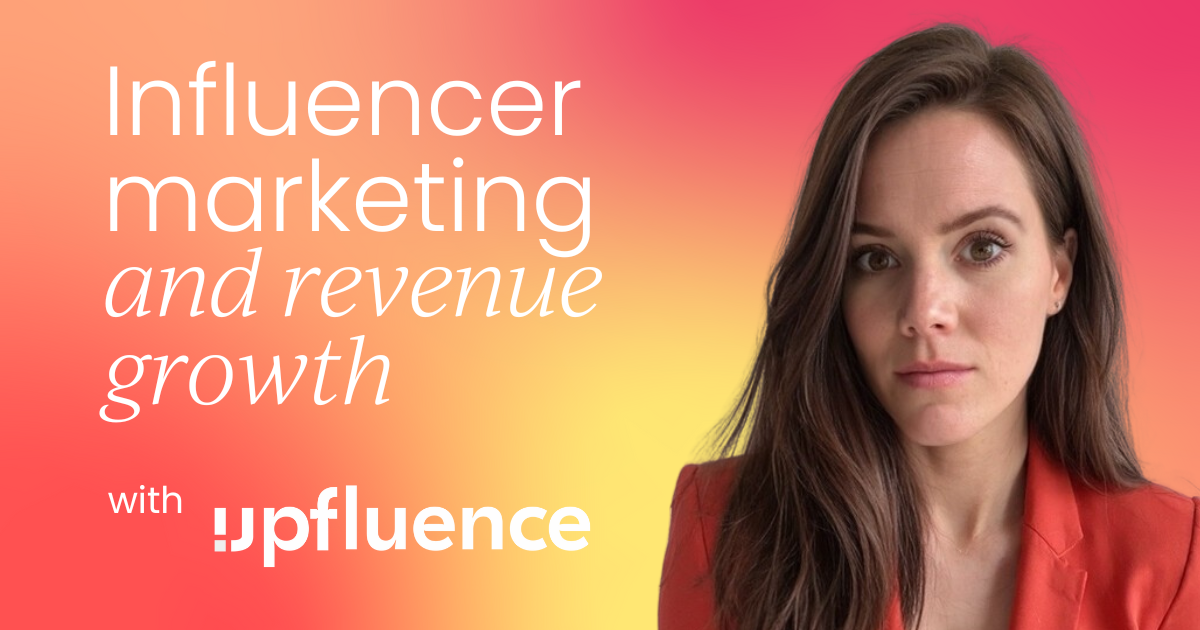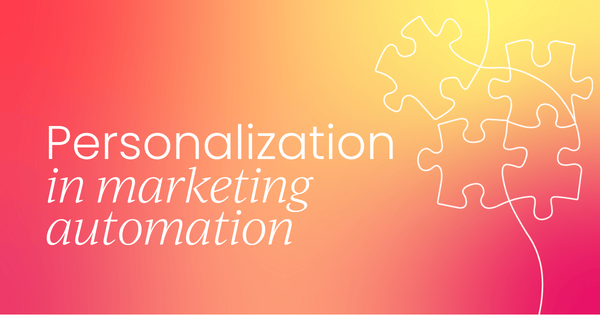Why personalization in marketing automation matters more than ever
“Over the next three years, 89% of marketing decision makers think [personalization] is going to be needed. And people expect personalization. They want a really great experience, and we should be delivering it.” – Kirsty Finlayson, Director of Marketing at Chameleon
People have a lot to choose from, as they can pick from dozens of brands, many of which offer similar products and services. What separates the winners from the others is the experience they’re able to create.
Think about your own inbox. When you get an email that really seems to understand issues you’re facing, you’re far more likely to open it, click through, and act. The same is true when your social ad speaks directly to something your customers were researching earlier that week.
And the data confirms it. A recent report shows that 96% of digital professionals agree that personalization is a must for great online customer experiences.
Also, McKinsey says that 71% of consumers expect personalized interactions, while 76% get frustrated when that doesn’t happen, which is a good reminder that emotional reactions are at play.
So, brands that get it right will probably have higher engagement because people react better to messages that seem relevant to them.
Plus, they’ll probably convert customers faster and build stronger relationships, with people more likely to stay loyal if they feel understood.
Marketing automation allows for this personalization to happen at scale, meaning you don’t have to manually reach thousands of people to deliver a custom experience.
Data is the foundation of your personalized campaigns
“You're always thinking about your audience and how you want to target them, and that has to include personalized messaging. Right? Sixty eight percent of customers expect brands to prioritize personalizing interactions. Businesses that use data-driven personalization have 5x to 8x higher ROI of marketing spend.” – Alyce Slocum, VP of Product and Audience Marketing at Trustpilot
To make personalization work, you need accurate, up-to-date, and actionable data; otherwise, any attempt at personalization ends up being guesswork – and quality data is just as important, since it lets you better tailor your messages.
The first thing you should do is get demographic information, which includes age, gender, job title, company size, and location. While these don’t tell the full story, they’re useful for grouping people.
After all, a CEO at a tech company and a small shop owner should get different messages.
Next, watch what people do (a.k.a., behavioral data): what pages do they visit, what emails do they open, what links do they click? Knowing this allows you to predict intent and give them content that matches where they are in their journey.
Also, you should look at transactional data, such as customers’ purchase history, order values, and buying frequency, which can help you decide what to offer people next.
Someone who’s bought a software subscription twice might be ready for an upsell to a premium plan. If they bought a seasonal product last year, they might appreciate a reminder when it’s available again.
You should also consider engagement data – surveys, feedback, and customer service chats – as they tell you how people feel about your company.
On top of all this, there’s contextual data too, which includes real-time info like the type of device people are using, their time zone, and even their location at the moment of engagement.
For instance, you could send a push notification with a lunch discount to someone who’s near one of your restaurants at midday.
Don’t try to get all this data at once. Progressive profiling is the way to go, so instead of asking for 15 fields of information in your first sign-up form, collect the essentials initially, then gradually request more details over time as the relationship develops.

Turn data into targeted messaging with segmentation
Once you have strong data, the next step is segmentation, meaning you should divide your audience into groups based on shared traits so you can tailor the message for each one.
For example, you might use demographic segmentation to group people by their role in a company, making sure that marketing managers get content focused on strategy while junior marketers get more tactical, how-to resources.
Beyond that, behavioral segmentation might target people who, for example, downloaded your ebook, with follow-up content that goes deeper into the topic.
In addition, segmentation by lifecycle stage is also crucial. Someone who just joined your mailing list isn’t ready for the same messaging as a long-term customer. Early-stage leads might need education about your industry, while sales-qualified leads might need case studies and proof points to push them toward a decision.
Overall, segmentation lets you speak to people where they are, not where you wish they were. Instead of blasting a generic campaign to everyone, you can create smaller, more relevant campaigns for each group (which will help you increase engagement and conversion rates).
Use dynamic content
While segmentation determines who receives your message, dynamic content determines what that message looks like when it’s delivered.
This is because this type of content changes based on the recipient’s profile or actions; it could be something like swapping out a product image based on your customer’s location.
Imagine a SaaS company with multiple product tiers. A visitor who has already viewed the pricing page for the premium plan might see a homepage banner highlighting a limited-time premium discount. Meanwhile, someone who’s only interacted with blog content about beginner topics might see a banner for a free starter guide.
This makes each interaction feel intentional and personal.
Consider behavior-triggered automation
Even the best messaging falls flat if it arrives at the wrong time. Behavior-triggered automation solves this by sending messages in direct response to a user’s actions.
For example, someone visits your pricing page twice in one week but doesn’t fill out the contact form. Instead of waiting for them to come back, you could send them an automated email the next day, where you offer to answer any questions they might have about pricing.
This strategy is also the classic abandoned cart scenario. These triggers work because they’re timely and relevant. They acknowledge what people just did (or didn’t do) and offer the next logical step, keeping the conversation going without feeling intrusive.
Multi-channel personalization
Personalization is more effective when it’s spread across multiple channels.
Think about how you interact with brands today. You might first see a Facebook ad, click through to their site, sign up for their newsletter, get an email, and then later see a retargeting ad on Instagram.
If each of those touchpoints feels disconnected, the experience breaks down. But if they all deliver a consistent, personalized message, it reinforces their brand and nudges you closer to taking action.
The key is ensuring all channels share the same customer data so personalization stays cohesive, no matter where the interaction happens.
Personalization in marketing automation: B2B vs B2C
While the core principles of personalization apply in both B2B and B2C contexts, the execution differs significantly.
In B2B, sales cycles are longer, decision-making often involves multiple stakeholders, and the content needs to be deeply educational. Personalization here might focus on the specific pain points of a company’s industry or role.
A B2B automation workflow might nurture leads over months, with each stage offering progressively more in-depth resources (e.g., whitepapers, webinars, case studies) until the prospect is ready for a sales conversation.
In B2C, buying cycles are often shorter and more impulse-driven. Personalization might lean heavily on timing and urgency, such as flash sales or limited-edition drops.
Here, automation might revolve around quick-trigger campaigns that respond to browsing behavior or purchase history in near real-time.
Understanding these differences ensures your personalization strategy feels natural to your audience and fits the context of how they make decisions.

Practical tips to make personalization in marketing automation actually work
Start with clean, unified data
To really nail personalization when automating your marketing efforts, you must start with clean, unified data. If your customer info is all over the place, even the best automation tool won't help.
That's why it's important to grab data from everywhere you interact with customers (your CRM, website, how they use your product, customer service chats, you name it) and place it all into one main spot.
Segment with purpose
Once you have a foundation in place, you can segment your data more effectively. It’s not enough to group people by demographics, as the real power is in behavioral and intent data, as we mentioned above.
Segmenting by purchase history, browsing activity, or engagement levels lets you create micro-segments that are far more responsive.
For example, “trial users who haven’t converted after seven days” is much more actionable than “trial users” as a whole. These more refined groups allow you to improve your targeting and messaging.
Apply personalization at the right level
Personalization should then be applied at different levels.
On the surface, you can work with names, company details, or locations, but the real impact comes from deeper personalization, like tailoring product recommendations and sending messages at the time each recipient is most likely to engage.
Striking the right balance is important; if personalization feels forced or irrelevant, it can do more harm than good.
“Let's not get creepy about it. That can happen very, very quickly. [Regarding website personalization] This is where you can get, like, really personal without creeping people out because they've probably already signed up to your products already. And there's a bit of an assumption going on here that you know them, and they know you.” – Kirsty Finlayson, Director of Marketing at Chameleon
Make timing work with triggers
Timing also plays a huge role in making personalization effective. Automated workflows triggered by customer behavior (e.g., cart abandonment, post-purchase upsell opportunities, or re-engagement campaigns) show people that you’re paying attention to their journey.
When these triggers are set correctly, messages arrive when they’re relevant, which makes them far more compelling than static campaigns.
Use dynamic content to add depth
Instead of sending one-size-fits-all emails or landing pages, automation tools allow you to tailor sections of content to match specific attributes of your audience.
A SaaS company, for example, might highlight security features for CTOs while focusing on ease of use and ROI for marketers.
This alignment of content to role, industry, or stage in the funnel makes every interaction feel more personal.
Balance automation with a human touch
Even with automation doing the heavy lifting, it’s important you maintain a human touch.
Automated personalization should enhance relationships, not replace them. Adding personal notes from sales reps, short video messages, or invitations to live events can keep the experience authentic and engaging.

Test, track, and optimize
None of this works without testing and refinement. Regularly A/B testing subject lines, timing, and personalization strategies is the only way to know what resonates with your audience.
Track open rates, click-throughs, conversions, and unsubscribe rates, as this helps you identify what’s working and what needs to be better.
Build trust through transparency
At the same time, respect for privacy and trust is non-negotiable. Customers should understand how their data is being used, and they should feel in control through preferences or easy opt-out options. If your customers feel that you’re being invasive, trust breaks down.
Align personalization to the customer journey
Finally, personalization should map the customer journey rather than being scattered across random touchpoints. In the awareness stage, this might mean sharing educational content tailored to someone’s industry.
In the consideration stage, it could be product comparisons or customer case studies. During the decision phase, ROI calculators or targeted incentives are more effective, and in retention, personalization should be about onboarding flows, loyalty rewards, and renewal reminders.
Don’t stop at conversion, as post-purchase personalization is often where the strongest long-term value is created.
Looking ahead
Artificial intelligence and machine learning go hand-in-hand with personalization.
They make it possible to analyze vast amounts of customer data in real time, predict future behavior, and tailor interactions on the fly.
AI-powered recommendations, hyper-personalized customer journeys, and real-time content adjustments are already becoming standard features in marketing platforms.
Voice search and conversational AI will add another layer, allowing brands to personalize experiences through natural, spoken interactions.
And, as these tools become more advanced, the line between human and automated interactions will blur even further.
However, a recent study found that 78% of global firms lack the data readiness needed for AI agents to work effectively.
That’s both a challenge and an opportunity. Once you unify and clean your data, AI agents will deliver hyper-personalized experiences like never before by crafting flawless, relevant conversations.
Final thoughts
Personalization in marketing automation is about creating experiences that make customers feel understood.
By grounding your strategy in high-quality data, segmenting correctly, using dynamic content, triggering timely messages, and maintaining consistency across channels, you can make automation feel personal rather than mechanical.






.png)









 Follow us on LinkedIn
Follow us on LinkedIn







